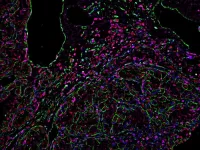(Press-News.org) The 2024 EULAR congress in Vienna included a clinical abstract session focusing on pain and prognosis in RA, where two groups presented their research into ways to characterise early RA.
The first looked at dissecting early RA patient trajectories through time-independent disease state patterns of inflammation in blood or joints. Presenting the work, Nils Steinz said “Previous studies have identified smooth time trajectories of rapid, slow, or no progression of disease activity, assessed through DAS28. In real life, we observe more chaotic disease evolvements – and particularly the detours could indicate a lack of adequate treatment.”
To address this, the researchers set out to discern trajectories of disease states of early RA over 1.5 years from the first outpatient clinic visit in real-world data from 1,237 patients with 5,017 visits to the Leiden rheumatology outpatient clinic. This was achieved using pseudo-time graph-based analyses of clustered visit data. Subsequently, patient trajectories were identified using a matching algorithm. To validate the findings, the pipeline was applied to data from the TACERA cohort, representing 244 patients with early seropositive RA. The results showed eight disease states, with swollen and tender joint count, erythrocyte sedimentation rate (ESR), and leukocytes as the major discriminating factors. One cluster was the clinically optimal disease state with the least inflammation overall. The sequence of disease states experienced by patients was grouped together to form four distinct trajectories. Some people had high ESR clusters at start and end. Others showed rapid progression towards the ideal cluster, no disease activity. The third group transitioned through high leucocyte state, and the fourth were classed as poor prognosis. In the TACERA analysis, the team found similar clusters and trajectories. These revealed interesting differences in age, gender, and serostatus – even though these variables were not included in the clustering. The differences were not driven by inclusion date, follow-up duration, symptom duration, or time to methotrexate initiation. But with the exception of the people with high ESR clusters at start and end, the trajectories could not be predicted by baseline variables.
These trajectories draw a more granular picture than previously described, and show early RA patients stranded in suboptimal disease states, with inflammation and poor response the main discriminatory factors. This approach provides insights into opportunities for improving care, such as more intensive treatment at an earlier stage. Work is ongoing, and the next step will be to characterise the immune profiles of the different disease states, and discern the impact of treatment decisions.
The second work also looked at patterns, but with a focus on non-articular pain – an issue which is common in early RA, and associated with lower remission rates.2 “Understanding common phenotypes of regional non-articular pain and the role of RA-related joint inflammation could help better personalise RA care,” said Charis Meng – presenter of the work from the Canadian Early Arthritis Cohort Study.
Data from 392 early RA patients were used to describe common non-articular pain presentations around the time of early RA diagnosis, as well as evolution over the first year of treatment, and associations with active inflammation. Prespecified pain patterns were classified based on non-articular pain reported in the four body quadrants and axial region,2,3 excluding hands and feet, and grouped as: no pain, regional, or widespread. Descriptive statistics were used to summarise the frequency and evolution of different patterns at baseline and over 12-month follow-up.
Over half of patients reported prevalent non-articular pain at baseline, of which nearly three-quarters were classed as regional. The most frequent patterns were axial (34%), pain in both upper quadrants (20%), and both lower quadrants (10%). Of those with prevalent regional pain, it persisted or worsened in 42% over 1 year. But for those with prevalent widespread pain, 73% resolved or improved to a regional pattern. Joint inflammation tended to be more frequently reported in corresponding locations with non-articular pain, and often persisted over follow-up. These findings suggest that non-articular pain is common in early RA and throughout the first year after diagnosis. The significantly higher frequency of tender or swollen joints within most areas of non-articular pain over time suggests RA activity may be a contributing factor. More studies are needed, but early intervention to prevent and treat non-articular pain in early RA is recommended.
Source
Steinz N, et al. Dissecting early RA patient trajectories through time-independent disease state identification identifies distinct patterns dissected by inflammation in blood or joints. Presented at EULAR 2024; OP0018.
Ann Rheum Dis 2024; DOI: 10.1136/annrheumdis-2024-eular.1512.
Meng C, et al. Characterizing Prevalent Non-Articular Pain at Early RA Diagnosis and Evolution Over the First Year of RA Treatment: Results from the Canadian Early Arthritis Cohort Study. Presented at EULAR 2024; OP0064.
Ann Rheum Dis 2024; DOI: 10.1136/annrheumdis-2024-eular.5946.
References
1. Combe B, et al. 2016 update of the EULAR recommendations for the management of early arthritis. Ann Rheum Dis 2017;76(6):948–59.
2. Bykerk VP, et al. Regional and widespread patterns of non-articular pain are common at RA diagnosis and contribute to poor outcomes at 12 months. Ann Rheum Dis 2020;79(Supp1):585.
3. Schelin M, et al. Widespread non-joint pain in early rheumatoid arthritis. Scand J Rheumatol 2021;50:271–9.
About EULAR
EULAR is the European umbrella organisation representing scientific societies, health professional associations and organisations for people with rheumatic and musculoskeletal diseases (RMDs). EULAR aims to reduce the impact of RMDs on individuals and society, as well as improve RMD treatments, prevention, and rehabilitation. To this end, EULAR fosters excellence in rheumatology education and research, promotes the translation of research advances into daily care, and advocates for the recognition of the needs of those living with RMDs by EU institutions.
Contact
EULAR Communications, communications@eular.org
Notes to Editors
EULAR Recommendations
EULAR School of Rheumatology
EULAR Press Releases
END
Early RA: Disease trajectories and pain
New work to uncover disease evolution
2024-06-12
ELSE PRESS RELEASES FROM THIS DATE:
Testing the thresholds
2024-06-12
However, this recommendation is not always followed in practice. This could be because the ASDAS was developed for research, and it is not known how well it performs in daily practice. Possibly, the cut-off of 2.1 as currently endorsed may be too strict in an everyday setting. To address this, Webers and colleagues set out to investigate which ASDAS cut-off values correspond best with treatment intensification in practice.
Data were taken from a prospective multi-centre registry for SpA, and treatment ...
Ingestible microbiome sampling pill technology advances
2024-06-12
Significant progress has been made at Tufts University School of Engineering in the development of a small device, about the size of a vitamin pill, that can be swallowed and passed through the gastrointestinal tract to sample the full inventory of microorganisms in an individual’s gastro-intestinal tract. This device has the potential to advance research on the relationship between resident bacteria and a wide range of health conditions. It could also serve as a diagnostic tool for adjusting the microbiome or administering drugs to treat those conditions.
The device has completed ...
Just thinking about a location activates mental maps in the brain
2024-06-12
As you travel your usual route to work or the grocery store, your brain engages cognitive maps stored in your hippocampus and entorhinal cortex. These maps store information about paths you have taken and locations you have been to before, so you can navigate whenever you go there.
New research from MIT has found that such mental maps also are created and activated when you merely think about sequences of experiences, in the absence of any physical movement or sensory input. In an animal study, the researchers found that the entorhinal cortex harbors a cognitive map of what animals experience while they use a joystick to browse through a sequence of images. ...
Obesity-cancer connection discovery suggests strategies for improving immunotherapy
2024-06-12
Immune system cells called macrophages play an unexpected role in the complicated connection between obesity and cancer, a Vanderbilt University Medical Center-led research team has discovered.
Obesity increases the frequency of macrophages in tumors and induces their expression of the immune checkpoint protein PD-1 — a target of cancer immunotherapies. The findings, published June 12 in the journal Nature, provide a mechanistic explanation for how obesity can contribute to both increased cancer ...
Smartwatches offer window into Parkinson's disease progression
2024-06-12
Ubiquitous wearable technologies, like smartwatches, could help researchers better understand progressive neurological disorders like Parkinson’s disease and speed up the approval of new therapies, a critical need given that no drugs exist to slow progression of the world’s fastest growing brain disease.
New research appearing today in the journal njp Parkinson’s Disease adds to growing evidence that widely used and user-friendly consumer devices, in this instance an Apple Watch paired with an iPhone, ...
What the geologic record reveals about how oceans were oxygenated 2.3 billion years ago
2024-06-12
About 2.5 billion years ago, free oxygen, or O2, first started to accumulate to meaningful levels in Earth’s atmosphere, setting the stage for the rise of complex life on our evolving planet.
Scientists refers to this phenomenon as the Great Oxidation Event, or GOE for short. But the initial accumulation of O2 on Earth was not nearly as straightforward as that moniker suggests, according to new research led by a University of Utah geochemist.
This “event” lasted at least 200 million years. And tracking the accumulation of O2 in the oceans has been very difficult until now, ...
Incidence of dementia before age 65 years among World Trade Center attack responders
2024-06-12
About The Study: In this cohort study of World Trade Center responders who survived these unique exposures and participated in a longitudinal follow-up study of cognition from 2014 through 2022, when compared with responders with the lowest exposure levels or responders who used personalized protective equipment (PPE), more severe exposure to dust or debris was significantly associated with a higher risk of dementia before 65 years of age. This study suggests that the reliable use of PPE might help prevent the onset of dementia before age 65 years among individuals exposed to an uncontrolled building collapse. Future ...
Neighborhood deprivation and breast cancer mortality among Black and white women
2024-06-12
About The Study: Neighborhood deprivation was associated with increased breast cancer mortality among non-Hispanic white women in this cohort study. Neighborhood racial composition, residential mobility, and rurality did not explain the lack of association among non-Hispanic Black women, suggesting that factors beyond those explored here may contribute to breast cancer mortality in this racial group.
Corresponding Author: To contact the corresponding author, Lauren E. Barber, Ph.D., email lauren.barber@emory.edu.
To access the embargoed study: Visit our For The Media website at this link https://media.jamanetwork.com/
(doi:10.1001/jamanetworkopen.2024.16499)
Editor’s ...
Hybrid work is a “win-win-win” for companies, workers
2024-06-12
It is one of the most hotly debated topics in today’s workplace: Is allowing employees to log in from home a few days a week good for their productivity, careers, and job satisfaction?
Nicholas Bloom, a Stanford economist and one of the foremost researchers on work-from-home policies, has uncovered compelling evidence that hybrid schedules are a boon to both employees and their bosses.
In a study, newly published in the journal Nature, of an experiment on more than 1,600 workers at Trip.com — a Chinese company that is one of the world’s largest online travel agencies — Bloom finds that employees who work from home ...
Inherited genetic factors may predict the pattern of X chromosome loss in older women
2024-06-12
hat: Researchers have identified inherited genetic variants that may predict the loss of one copy of a woman’s two X chromosomes as she ages, a phenomenon known as mosaic loss of chromosome X, or mLOX. These genetic variants may play a role in promoting abnormal blood cells (that have only a single copy of chromosome X) to multiply, which may lead to several health conditions, including cancer. The study, co-led by researchers at the National Cancer Institute, part of the National Institutes of Health, was published ...
LAST 30 PRESS RELEASES:
Sports injuries sustained during your period might be more severe
World's first successful 2 Tbit/s free-space optical communication using small optical terminals mountable on satellites and HAPS
Can intimate relationships affect your heart? New study says ‘yes’
Scalable and healable gradient textiles for multi‑scenario radiative cooling via bicomponent blow spinning
Research shows informed traders never let a good climate crisis go to waste
Intelligent XGBoost framework enhances asphalt pavement skid resistance assessment
Dual-function biomaterials for postoperative osteosarcoma: Tumor suppression and bone regeneration
New framework reveals where transport emissions concentrate in Singapore
NTP-enhanced lattice oxygen activation in Ce-Co catalysts for low-temperature soot combustion
Synergistic interface engineering in Cu-Zn-Ce catalysts for efficient CO2 hydrogenation to methanol
COVID-19 leaves a lasting mark on the human brain
Scientists use ultrasound to soften and treat cancer tumors without damaging healthy tissue
Community swimming program for Black youth boosts skills, sense of belonging, study finds
Specific depressive symptoms in midlife linked to increased dementia risk
An ‘illuminating’ design sheds light on cholesterol
Who is more likely to get long COVID?
Study showcases resilience and rapid growth of “living rocks”
Naval Research Lab diver earns Office of Naval Research 2025 Sailor of the Year
New Mayo-led study establishes practical definition for rapidly progressive dementia
Fossil fuel industry’s “climate false solutions” reinforce its power and aggravate environmental injustice
Researchers reveal bias in a widely used measure of algorithm performance
Alcohol causes cancer. A study from IOCB Prague confirms damage to DNA and shows how cells defend against it
Hidden viruses in wastewater treatment may shape public health risks, study finds
Unlock the power of nature: how biomass can transform climate mitigation
Biochar reshapes hidden soil microbes that capture carbon dioxide in farmland
Reducing saturated fat intake shows mortality benefit, but only in high-risk individuals
Manta rays create mobile ecosystems, study finds
Study: Mixed results in using lipoic acid to treat progressive multiple sclerosis
Norbert Holtkamp appointed director of Fermi National Accelerator Laboratory
New agentic AI platform accelerates advanced optics design
[Press-News.org] Early RA: Disease trajectories and painNew work to uncover disease evolution


